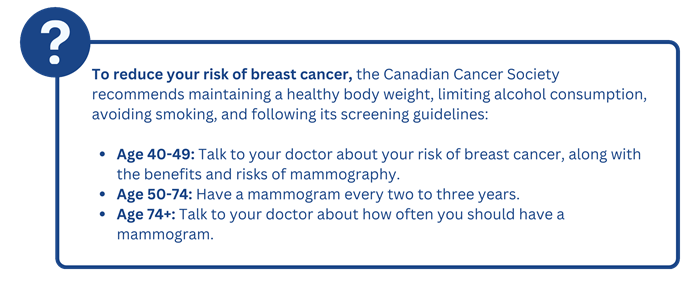Chances are you know someone whose life has been touched by breast cancer. In Canada, it’s the most common type of cancer for women: one in eight will develop breast cancer in their lifetime, and one in 31 will die of the disease.
Advancements in medical research, screening, and treatment have significantly improved survival rates over the past 30 years. However, breast cancer remains a life-altering disease with serious physical and emotional effects.
What is Carepath?
Carepath is a cancer assistance program backed by oncology physicians that provides medical and emotional support to plan members and their families. OTIP plan members who have long term disability (LTD) coverage and their eligible family members can access Carepath’s services.
.png.aspx?width=700&height=141)
What is breast cancer?
Like other types of cancer, breast cancer is caused by abnormal cells that grow uncontrollably, forming a tumor. The growth is malignant (cancerous) if it spreads to other parts of the body. Not all abnormal growths are cancer; there are also benign conditions that affect the breasts.
Did you know? Breast cancer is rare in men, but it can happen, accounting for less than one percent of cases.
Risk Factors
A person’s chances of developing breast cancer depend on their unique combination of internal and external risk factors. The Canadian Cancer Society lists several known risk factors:
-
Prior diagnosis of breast cancer
-
Family history of breast cancer and other types of cancer
-
Mutations to breast cancer genes (mutations are rare, affecting one in 500 people)
-
Dense breast tissue, which is an inherited trait
-
Reproductive history: breast cancer risk is higher for women who had their first period early (age 11 or younger) or entered menopause late (age 55 or older), or who had their first full-term pregnancy after age 30 or who have never been pregnant
-
Rare genetic conditions, including specific gene mutations
-
Exposure to ionizing radiation (for example, radiation therapy for Hodgkin lymphoma)
-
Taking oral contraceptives containing estrogen and progesterone for 10 years or more (this risk decreases if medication is discontinued)
-
Taking hormone replacement therapy (HRT) for 5+ years
-
Alcohol consumption, even at low levels (a little more than one drink per day)
-
Obesity, which increases breast cancer risk in post-menopausal women
-
Tall adult height, which is indicative of two factors that increase risk: a person’s energy intake and diet early in life
-
High socio-economic status, which tends to be associated with having fewer children and/or having children later in life – both linked to increased breast cancer risk
Other possible risk factors include physical inactivity, adult weight gain, higher weight at birth, smoking (including exposure to second-hand smoke), and working night shifts (which affects the amount of melatonin in the body).

Signs and Symptoms
These signs and symptoms don’t necessarily indicate cancer, but it’s best to consult your doctor. Early cancer detection increases the success of treatment.
-
Lump in the breast that doesn’t shrink or disappear during your menstrual cycle. It might feel like it’s attached to the skin or chest wall. The lump may be hard or tender.
-
Lump in the armpit
-
A change in the size or shape of the breast
-
Dimpling, puckering, or thickening of the skin of the breast
-
Redness, swelling, and increased warmth in the breast
-
Changes to the nipple (for example, non-inverted nipples become inverted, nipple has unusual discharge, or nipple has scaling, crusting, or ulcers)
-
Itchy nipple or breast
Late signs and symptoms that may indicate that cancer has spread include nausea, bone pain, loss of appetite, jaundice, weight loss, headache, double vision, and muscle weakness. If you experience unusual symptoms, see your doctor.
Diagnosing Breast Cancer
Tests for breast cancer diagnosis and staging (determining whether the cancer has spread) include physical examination, mammography, ultrasound, and other imaging tests. A breast biopsy, in which a small amount of tissue is removed and checked for cancerous cells, is the only definite way to diagnose cancer. Additional tests (such as blood tests, lymph node biopsy, bone scans, and chest X-rays) help determine the cancer’s stage.

Treating Breast Cancer
People who have cancer are treated by an oncologist, a physician who specializes in cancer. The treatment plan depends on the type of breast cancer, its stage (tumor size, and whether it has spread), its grade (how the cells look and behave – for example, how quickly the tumor is growing), and other factors. Oncologists also consider a woman’s age, overall health, and personal decisions about treatment.
Treatment may include surgery, radiation therapy, hormone therapy, chemotherapy, hormonal therapy, or biological therapy.

Life after Breast Cancer
Following treatment, individuals continue with regular medical check-ups and cancer screening. A comprehensive wellness plan, collaboratively crafted with healthcare professionals, empowers individuals to regain their strength, effectively manage stress and side effects, and significantly reduce the risk of cancer recurrence.
.png.aspx?width=700&height=252)
Connecting with others who have walked a similar path can also be incredibly valuable. To locate peer and family support groups, reach out to your local Canadian Cancer Society office or engage in the organization's online community, CancerConnection.ca. Additionally, professional counseling is available to assist individuals in coping with the emotional and psychological aspects of the breast cancer journey.
Carepath's Chronic Disease program offers unwavering support, spanning from initial diagnosis through treatment and recovery for both members and their families, as they manage various types and stages of chronic diseases.
OTIP plan members who have long term disability (LTD) coverage and their eligible family members can access Carepath’s services. To learn more, visit otip.carepath.ca.
Resources:
Canadian Cancer Society
Cancer Care Ontario
Canadian Breast Cancer Foundation